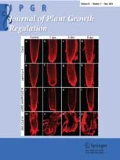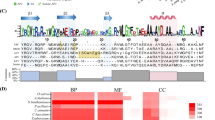Abstract
Members of the ERF transcription factor family have significant functions in regulating gene expression in response to biotic and abiotic stresses. In melon (Cucumis melo L.), however, few ERF genes have been studied. In this study, we performed a comprehensive computational analysis of 119 ERF family genes and identified 136 ERF superfamily genes in melon. We present a complete overview of ERF family gene in melon, including the phylogeny, gene structures, and putative conserved motifs of melon ERF family proteins, as well as a comparative analysis between ERF subfamily genes in cucumber. The AP2/ERF gene superfamily in melon can be classified into three families, ERF (ethylene-responsive factor), RAV (related to ABI3/VP1), and AP2 (APETALA2), which comprise 119, 4, and 13 members, respectively. The ERF family in melon was divided into 11 groups, designated I to XI, as in tomato. Our motif analysis indicated that most conserved motifs outside of the AP2/ERF domain are distributed between different clades in the phylogenetic tree. Most ERF family genes have no introns. Based on the observation that 11 of these groups existed in melon, we concluded that the chief functional diversification in the ERF family predated the divergence between monocots and dicots. In our analysis of expression patterns, ERF subfamily genes were distributed widely throughout melon plant tissues and most of the ERF subfamily genes were detected in all seven types of tissues. Some ERF subfamily genes show expression patterns characteristic of tissue-specific expression, implying their probability of performing various roles in growth and development in melon.












Similar content being viewed by others
References
Aida M, Beis D, Heidstra R and others (2004) The PLETHORA genes mediate patterning of the Arabidopsis root stem cell niche. J Cell 119:109–120
Altschul SF, Gish W, Miller W, Myers EW, Lipman DJ (1990) Basic local alignment search tool. J Mol Biol 215:403–410
Bailey TL, Elkan C (1995) The value of prior knowledge in discovering motifs with MEME. Proc Int Conf Intell Syst Mol Biol 3:21–29
Bailey TL, Williams N, Misleh C and others (2006) MEME: discovering and analyzing DNA and protein sequence motifs. Nucleic Acids Res 34:369–373
Bailey TL, Boden M, Buske FA and others (2009) MEME SUITE: tools for motif discovery and searching. Nucleic Acids Res 37:202–208
Boualem A, Fergany M, Fernandez R, Troadec C, Martin A and others (2008) A conserved mutation in an ethylene biosynthesis enzyme leads to andromonoecy in melons. Science 321:836–838
Chenna R, Sugawara H, Koike T, Lopez R, Gibson TJ (2003) Multiple sequence alignment with the clustal series of programs. Nucleic Acids Res 31:3497–3500
Chung MY, Vrebalov J, Alba R and others (2010) A tomato (Solanum lycopersicum) APETALA2/ERF gene, SlAP2a, is a negative regulator of fruit ripening. Plant J 64:936–947
Clepet and others (2011) Analysis of expressed sequence tags generated from full-length enriched cDNA libraries of melon. BMC Genome 12:252
Ei-Sharkawy I, Sherif S, Mila I and others (2009) Molecular characterization of seven genes encoding ethylene-responsive transcriptional factors during plum fruit development and ripening. J Exp Bot 60(3):907–922
Ezura H, Owino WO (2008) Melon, an alternative model plant for elucidating fruit ripening. Plant Sci 175:121–129
Fujimoto SY, Ohta M, Usui A, Shinshi H, Ohme-Takagi M (2000) Arabidopsis ethylene-responsive element binding factors act as transcriptional activators or repressors of GCC box-mediated gene expression. Plant Cell 12:393–404
Garcia-Mas J, Benjak A, Sanseverino W and others (2012) The genome of melon (Cucumis melo L.). PNAS 109:11872–11877
Giovannoni JJ (2007) Fruit ripening mutants yield insights into ripening control. Curr Opin Plant Biol 10:283–289
Gomez G, Torres H, Pallas V (2005) Identification of translocatable RNA-binding phloem proteins from melon, potential components of the long-distance RNA transport system. Plant J 41:107–116
Guillaumota D, Lelu-Walterb MA and others (2008) Expression patterns of LmAP2L1 and LmAP2L2 encoding two APETALA2 domain proteins during somatic embryogenesis and germination of hybrid larch (Larix × marschlinsii). J Plant Physiol 165:1003–1010
Hall TA (1999) BioEdit: a user-friendly biological sequence alignment editor and analysis program for Windows 95/98/NT. Nucleic Acids Symp Ser 41:95–98
Haritatos E, Keller F, Turgeon R (1996) Raffinose oligosaccharide concentrations measured in individual cell and tissue types in Cucumis melo L. Leaves: implication for phloem loading. Planta 198:614–622
Hu LF, Liu SQ (2011) Genome-wide identification and phylogenetic analysis of the ERF gene family in cucumbers. Genet Mol Biol 34(4):624–633
Irish VF (1998) Floral development in Arabidopsis. Plant Physiol Biochem 36(1–2):61–68
Jeffrey C (2005) A new system of Cucurbitaceae. Bot Zhurn 90:332–335
Jeffrey C, De Wilde WJJO (2006) A review of the subtribe Thladianthinae (Cucurbitaceae). Bot Zhurn 91:766–776
Jofuku KD, den Boer BG, Van Montagu M, Okamuro JK (1994) Control of Arabidopsis flower and seed development by the homeotic gene APETALA2. Plant Cell 6:1211–1225
Kagaya Y, Ohmiya K, Hattori T (1999) RAV1, a novel DNA-binding protein, binds to bipartite recognition sequence through two distinct DNA-binding domains uniquely found in higher plants. Nucleic Acids Res 27:470–478
Klucher KM, Chow H, Reiser L and others (1996) The AINTEGUMENTA gene of Arabidopsis required for ovule and female gametophyte development is related to the floral homeotic gene APETALA2. Plant Cell 8(2):137–153
Kranz HD, Denekamp M, Greco R, Jin H, Leyva A, Meissner RC, Petroni K, Urzainqui A, Bevan M, Martin C and others (1998) Towards functional characterization of the members of the R2R3-MYB gene family from Arabidopsis thaliana. Plant J 16:263–276
Lee JM, Joung JG, McQuinn R and others (2012) Combined transcriptome, genetic diversity and metabolite profiling in tomato fruit reveals that the ethylene response factor SlERF6 plays an important role in ripening and carotenoid accumulation. Plant J 70:191–204
Letunic I, Doerks T, Bork P (2009) SMART 6: recent updates and new developments. Nucleic Acids Res 37:229–232
Licausi F, Giorgi FM, Zenoni S and others (2010) Genomic and transcriptomic analysis of the AP2/ERF superfamily in Vitis vinifera. BMC Genome 11:719
Liu L, White MJ, MacRae TH (1999) Transcription factors and their genes in higher plants functional domains, evolution and regulation. Eur J Biochem 262:247–257
Magnani E, Sjölanderc K, Hakea S (2004) From endonucleases to transcription factors: evolution of the AP2 DNA binding domain in plants. Plant Cell 16:2265–2277
Martin A, Troadec C, Boualem A, Rajab M, Fernandez R and others (2009) A transposon-induced epigenetic change leads to sex determination in melon. Nature 461:1135–1138
Mizuno S, Hirasawa Y, Sonsda M and others (2006) Isolation and characterization of three DREB/ERF-type transcription factors from melon (Cucumis melo). Plant Sci 170:1156–1163
Nakano T, Suzuki K, Fujimura T, Shinshi H (2006) Genome-wide analysis of the ERF gene family in Arabidopsis and rice. Plant Physiol 140:411–432
Nilsson L, Carlsbecker A, Sundas-Larsson A and others (2006) APETALA2 like genes from Picea abies show functional similarities to their Arabidopsis homologues. J Planta 225:589–602
Nunez-Palenius HG, Gomez-Lim M, Ochoa-Alejo N, Grumet R, Lester G, Cantliffe DJ (2008) Melon fruits: genetic diversity, physiology, and biotechnology features. Crit Rev Biotechnol 28:13–55
Ohme-Takagi M, Shinshi H (1995) Ethylene-inducible DNA binding proteins that interact with an ethylene-responsive element. Plant Cell 7:173–182
Ohta M, Matsui K, Hiratsu K, Shinshi H, Ohme-Takagi M (2001) Repression domains of class II ERF transcriptional repressors share an essential motif for active repression. Plant Cell 13:1959–1968
Pãrenicova L, de Folter S, Kieffer M, Horner DS, Favalli C, Busscher J, Cook HE, Ingram RM, Kater MM, Davies B and others (2003) Molecular and phylogenetic analyses of the complete MADS-box transcription factor family in Arabidopsis: new openings to the MADS world. Plant Cell 15:1538–1551
Pech JC, Bouzayen M, Latché A (2008) Climacteric fruit ripening: ethylene-dependent and independent regulation of ripening pathways in melon fruit. Plant Sci 175:114–120
Portnoy V, Diber A, Pollock S and others (2011) Use of non-normalized, non-amplified cDNA for 454-based RNA sequencing of fleshy melon fruit. Plant Genome 4:36–46
Reyes JC, Muro-Pastor MI, Florencio FJ (2004) The GATA family of transcription factors in Arabidopsis and rice. Plant Physiol 134:1718–1732
Riechmann JL, Heard J, Martin G, Reuber L, Jiang C, Keddie J, Adam L, Pineda O, Ratcliffe OJ, Samaha RR and others (2000) Arabidopsis transcription factors: genome-wide comparative analysis among eukaryotes. Science 290:2105–2110
Saitou N, Nei M (1987) The neighbor-joining method: a new method for reconstructing phylogenetic trees. Mol Biol Evol 4:406–425
Sakuma Y, Liu Q, Dubouzet JG, Abe H, Shinozaki K, Yamaguchi-Shinozaki K (2002) DNA-binding specificity of the ERF/AP2 domain of Arabidopsis DREBs, transcription factors involved in dehydration- and cold-inducible gene expression. Biochem Biophys Res Commun 290:998–1009
Schmid M, Uhlenhaut NH, Godard F and others (2003) Dissection of floral induction pathways using global expression analysis. J Dev 130:6001–6012
Schultz J, Milpetz F, Bork P, Ponting CP (1998) SMART, a simple modular architecture research tool: identification of signaling domains. Proc Natl Acad Sci USA 95:5857–5864
Sharma MK, Kumar R, Solanke AU and others (2010) Identification, phylogeny, and transcript profiling of ERF family genes during development and abiotic stress treatments in tomato. Mol Genet Genomics 284:455–475
Sharoni AM, Nuruzzaman M, Satoh K and others (2011) Gene structures, classification and expression models of the AP2/EREBP transcription factor family in rice. Plant Cell Physiol 52(2):344–360
Tamura K, Dudley J, Nei M, Kumar S (2007) MEGA4: molecular evolutionary genetics analysis(MEGA)software version 4.0. Mol Biol Evol 24:1596–1599
Tian C, Wan P, Sun S, Li J, Chen M (2004) Genome-wide analysis of the GRAS gene family in rice and Arabidopsis. Plant Mol Biol 54:519–532
Toledo-Ortiz G, Huq E, Quail PH (2003) The Arabidopsis basic/helixloop-helix transcription factor family. Plant Cell 15:1749–1770
Wang Y, Deng D, Bian Y, Lv Y and others (2010) Genome-wide analysis of primary auxin-responsive Aux/IAA gene family in maize (Zea mays L.). Mol Biol Rep 37:3991–4001
Yin XR, Allan AC, Chen KS and others (2010) Kiwifruit EIL and ERF genes involved in regulating fruit ripening. Plant Physiol 153:1280–1292
Zhang GY, Chen M, Chen XP and Xu ZS (2008) Phylogeny, gene structures, and expression patterns of the ERF gene family in soybean (Glycine max L.). J Exp Bot 59:4095–4107
Zhang CH, Shangguan LF, Ma RJ, Sun X and others (2012) Genome-wide analysis of the AP2/ERF superfamily in peach (Prunus persica). Genet Mol Res 11:4789–4809
Zhuang J, Cai B, Peng RH and others (2008) Genome-wide analysis of the AP2/ERF gene family in Populus trichocarpa. Biochem Biophys Res Commun 371:468–474
Zhuang J, Peng RH, Cheng ZM and others (2009) Genome-wide analysis of the putative AP2/ERF family genes in Vitis vinifera. Sci Hortic 123:73–81
Acknowledgments
This work was supported by the National Natural Science Foundation of China (31360486).
Author information
Authors and Affiliations
Corresponding author
Electronic supplementary material
Below is the link to the electronic supplementary material.
Rights and permissions
About this article
Cite this article
Ma, Y., Zhang, F., Bade, R. et al. Genome-Wide Identification and Phylogenetic Analysis of the ERF Gene Family in Melon. J Plant Growth Regul 34, 66–77 (2015). https://doi.org/10.1007/s00344-014-9443-z
Received:
Accepted:
Published:
Issue Date:
DOI: https://doi.org/10.1007/s00344-014-9443-z




